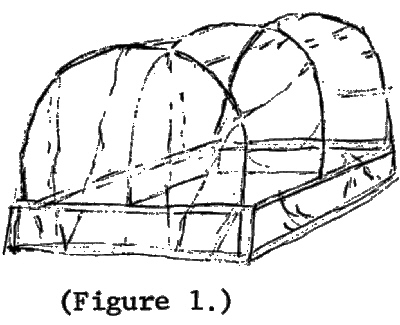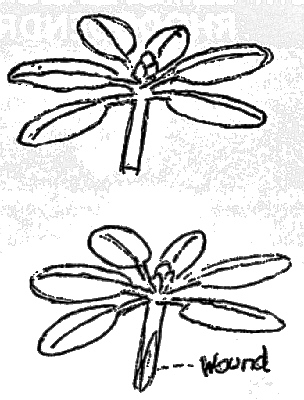QBARS - v31n3 A Five Step Plan to Successful Rhododendron Propagation
A Five Step Plan To Successful Rhododendron Propagation
Al La Porte, Nesconset, New York
Reprinted from the New York Chapter Newsletter
Do you have an enclosed porch or a bright spot in a little used room? Then you too can propagate the 'King of Shrubs' and contract a case of that incurable disease, "Rhododendronitis."
There are two basic methods for rooting rhododendrons - the cold and warm (bottom heat) methods. This article will endeavor to describe the warm method in five steps.
1. The Leach polyethylene frame, (developed by A. H. S. President, Dr. David Leach), is a low maintenance, easy-to-make rooting bench. (Figure 1.)

|
Obtain or make a flat with a depth of 4 to 6 inches. The frame should be 15 inches or more above the rooting bed. This structure is then enclosed (except for the front flap) in 4-mil polyethylene (obtainable at most hardware stores). Polyethylene has the unique properties of allowing oxygen and carbon dioxide to pass through without letting moisture escape from the bench.
2. What medium should you use? Fresh mushroom manure? Heavy sand? Or shredded Styrofoam? Neither these nor any other exotic, difficult-to-obtain mediums are necessary for successful results. Obtain two readily available ingredients: perlite (medium propagating grade) and peat moss (the highest quality available). Prepare a mixture of 50 percent perlite and 50 percent peat moss. Soak this medium in water over night prior to placing it in your propagating frame.
3. To provide bottom heat, purchase a heating cable (carried by the better garden centers). Place a two inch layer of rooting medium in the rooting bench. Put the heating cable on top of the medium. Lightly cover the heating cable with additional peat/perlite mix. A piece of fine copper screening goes on top of the heating cable, but not touching it. The screening encourages formation of a superior root structure. The remaining rooting medium is now put in the bench.
4. Cuttings may be taken from mid-September through December. The optimum time for most varieties is September and October. Take cuttings 2½ to 3 inches in length from the shady side of plants, not the heavy wooded top growth. Remove excess leaves, but leave three or four leaves for large leaved varieties. (Figure 2.) Next, make fairly deep side slices approximately 1½ inches in length on both sides of the cutting. This procedure of wounding both sides will produced a balanced root ball.

|
5. The hormone IBA (Indolebutyric acid) has made rhododendron propagation feasible to all interested. A two percent powder of IBA will successfully root most rhododendrons including the formerly difficult reds such as 'E. S. Rand' and 'Nova Zembla'. Two percent IBA is available at all N.Y. chapter ARS meetings. Dip your cutting in the two percent IBA and insert about two inches into the rooting medium. Close the polyethylene around the frame and plug in the heating cable. Your cuttings will be luxuriously rooted in 8 to 14 weeks.
Follow-up-Care:
1. Do supplemental watering every four to six weeks, as required.
2. Disconnect the heating cable in 2½ to 3 months.
3. Pinch out the enlarged terminal bud to encourage branching.
4. Do not set your plants outside until all danger of frost is over (usually around the third week of May) unless you have a cold frame. This method of propagation has given me 90 to 98 per cent rooting success over the past several years.
